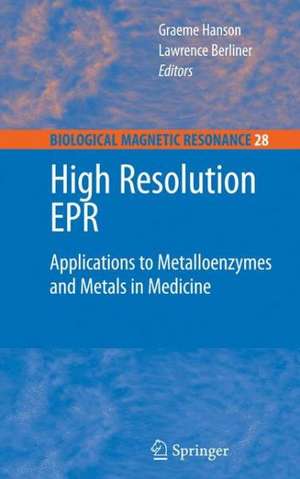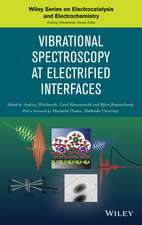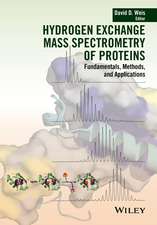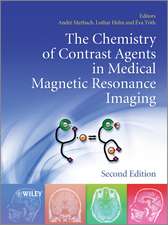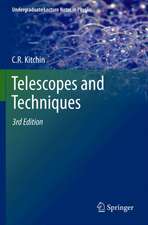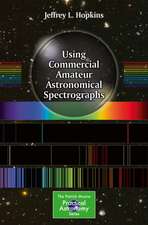High Resolution EPR: Applications to Metalloenzymes and Metals in Medicine: Biological Magnetic Resonance, cartea 28
Editat de Graeme Hanson, Lawrence Berlineren Limba Engleză Hardback – 29 iun 2009
This volume was conceived in 2005 at the Rocky Mountain Conference on Analytical Chemistry (EPR Symposium) to highlight the importance of high-resolution EPR spectroscopy to the structural (geometric and electronic) characterization of redox active cofactors in metalloproteins. We have been fortunate to have enlisted internationally recognized experts in this joint venture to provide the scientific community with an overview of high-resolution EPR and its application to metals in biology. This volume, High-Resolution EPR: Applications to Metalloenzymes and Metals in Medicine, covers high-resolution EPR methods, iron proteins, nickel and copper enzymes, and metals in medicine. An eloquent synopsis of each chapter is provided by John Pilbrow in the Introduction. A second volume, Metals in Biology: Applications of High-Resolution EPR to Metalloenzymes, will appear later this year covering the complement of other metalloproteins.
One of the pioneers in the development of pulsed EPR and its application to metalloproteins was Arthur Schweiger, whose contribution we include in this volume. Unfortunately, he passed away suddenly during the preparation of this volume. The editors andcoauthors are extremely honored to dedicate this volume to the memory of Arthur Schweiger in recognition of his technical advances and insights into pulsed EPR and its application to metalloproteins. Arthur was extremely humble and treated everyone with equal respect. He was a gifted educator with an ability to explain complex phenomena in terms of simple intuitive pictures, had a delightful personality, and continues to be sadly missed by the community.
It is an honor for the editors to facilitate the dissemination of these excellent contributions to the scientific community. Suggestions for future volumes are always appreciated.
| Toate formatele și edițiile | Preț | Express |
|---|---|---|
| Paperback (1) | 1431.45 lei 43-57 zile | |
| Springer – 30 oct 2014 | 1431.45 lei 43-57 zile | |
| Hardback (1) | 1438.78 lei 43-57 zile | |
| Springer – 29 iun 2009 | 1438.78 lei 43-57 zile |
Din seria Biological Magnetic Resonance
-
 Preț: 388.72 lei
Preț: 388.72 lei - 18%
 Preț: 951.14 lei
Preț: 951.14 lei - 18%
 Preț: 1225.48 lei
Preț: 1225.48 lei -
 Preț: 391.02 lei
Preț: 391.02 lei - 5%
 Preț: 376.22 lei
Preț: 376.22 lei - 5%
 Preț: 374.20 lei
Preț: 374.20 lei - 18%
 Preț: 958.07 lei
Preț: 958.07 lei - 5%
 Preț: 1416.09 lei
Preț: 1416.09 lei - 5%
 Preț: 1423.22 lei
Preț: 1423.22 lei - 5%
 Preț: 2126.73 lei
Preț: 2126.73 lei - 5%
 Preț: 1444.08 lei
Preț: 1444.08 lei - 5%
 Preț: 1426.71 lei
Preț: 1426.71 lei - 5%
 Preț: 1097.54 lei
Preț: 1097.54 lei - 5%
 Preț: 739.69 lei
Preț: 739.69 lei - 5%
 Preț: 402.11 lei
Preț: 402.11 lei - 5%
 Preț: 2123.06 lei
Preț: 2123.06 lei - 5%
 Preț: 1427.98 lei
Preț: 1427.98 lei - 15%
 Preț: 643.65 lei
Preț: 643.65 lei - 5%
 Preț: 1433.46 lei
Preț: 1433.46 lei - 5%
 Preț: 1412.99 lei
Preț: 1412.99 lei - 5%
 Preț: 1431.45 lei
Preț: 1431.45 lei -
 Preț: 387.96 lei
Preț: 387.96 lei - 18%
 Preț: 1689.69 lei
Preț: 1689.69 lei - 5%
 Preț: 720.84 lei
Preț: 720.84 lei - 5%
 Preț: 717.20 lei
Preț: 717.20 lei - 18%
 Preț: 891.65 lei
Preț: 891.65 lei - 18%
 Preț: 942.44 lei
Preț: 942.44 lei - 15%
 Preț: 642.83 lei
Preț: 642.83 lei
Preț: 1438.78 lei
Preț vechi: 1514.51 lei
-5% Nou
Puncte Express: 2158
Preț estimativ în valută:
275.30€ • 288.22$ • 227.80£
275.30€ • 288.22$ • 227.80£
Carte tipărită la comandă
Livrare economică 07-21 aprilie
Preluare comenzi: 021 569.72.76
Specificații
ISBN-13: 9780387848556
ISBN-10: 038784855X
Pagini: 666
Ilustrații: XXV, 666 p.
Dimensiuni: 155 x 235 x 37 mm
Greutate: 1.14 kg
Ediția:2009
Editura: Springer
Colecția Springer
Seria Biological Magnetic Resonance
Locul publicării:New York, NY, United States
ISBN-10: 038784855X
Pagini: 666
Ilustrații: XXV, 666 p.
Dimensiuni: 155 x 235 x 37 mm
Greutate: 1.14 kg
Ediția:2009
Editura: Springer
Colecția Springer
Seria Biological Magnetic Resonance
Locul publicării:New York, NY, United States
Public țintă
Professional/practitionerCuprins
HIGH-RESOLUTION EPR METHODS.- Advanced Pulse EPR Methods for the Characterization of Metalloproteins.- Probing Structural and Electronic Parameters in Randomly Oriented Metalloproteins by Orientation-Selective ENDOR Spectroscopy.- Molecular Sophe: An Integrated Approach to the Structural Characterization of Metalloproteins: The Next Generation of Computer Simulation Software.- Spin-Hamiltonian Parameters from First Principle Calculations: Theory and Application.- IRON PROTEINS.- EPR of Mononuclear Non-Heme Iron Proteins.- Binuclear Non-Heme Iron Enzymes.- Probing the Structure#x2013;Function Relationship of Heme Proteins Using Multifrequency Pulse EPR Techniques.- EPR Studies of the Chemical Dynamics of NO and Hemoglobin Interactions.- NICKEL AND COPPER ENZYMES.- EPR Investigation of [NiFe] Hydrogenases.- Unique Spectroscopic Features and Electronic Structures of Copper Proteins: Relation to Reactivity.- METALS IN MEDICINE.- Insulin-Enhancing Vanadium Pharmaceuticals: The Role of Electron Paramagnetic Resonance Methods in the Evaluation of Antidiabetic Potential.- Chromium in Cancer and Dietary Supplements.- High-Frequency EPR and ENDOR Characterization of MRI Contrast Agents.
Notă biografică
Prof. Graeme Hanson, located in the Centre for Magnetic Resonance at the University of Queensland, has applied a unique synergistic approach involving both theoretical and experimental aspects of multifrequency continuous wave and pulsed EPR spectroscopy to structurally (geometric and electronic) characterise the metal binding sites in metalloenzymes and transition metal ion complexes. The development and commercialisation of the XSophe-Sophe-XeprView (CW EPR) and Molecular Sophe(CW EPR, Pulsed EPR and ENDOR) computer simulation software suites has been crucial in the characterisation of these biological inorganic systems.
Dr. Lawrence J. Berliner is currently at the Department of Chemistry and Biochemistry, University of Denver, where he was Professor and Chair for the past 8 years. He retired from The Ohio State University, where he spent a 32-year career in the area of biological magnetic resonance (EPR and NMR). He has been recognized by the International EPR Society with the Silver Medal for Biology/Medicine in 2000. He also received the Lifetime Achievement Award in Biological EPR Spectroscopy at EPR-2005. He is the Series Editor for Biological Magnetic Resonance, which he launched in 1979.
Dr. Lawrence J. Berliner is currently at the Department of Chemistry and Biochemistry, University of Denver, where he was Professor and Chair for the past 8 years. He retired from The Ohio State University, where he spent a 32-year career in the area of biological magnetic resonance (EPR and NMR). He has been recognized by the International EPR Society with the Silver Medal for Biology/Medicine in 2000. He also received the Lifetime Achievement Award in Biological EPR Spectroscopy at EPR-2005. He is the Series Editor for Biological Magnetic Resonance, which he launched in 1979.
Textul de pe ultima copertă
High Resolution EPR: Applications to Metalloenzymes and Metals in Medicine
Prof. Graeme Hanson, University of Queensland and Prof. Lawrence Berliner, University of Denver
Metalloproteins are involved in a variety of biologically important processes, including metal ion and oxygen transport, biosynthesis, electron transfer, biodegradation, drug metabolism, proteolysis and peptide hydrolysis, environmental oxygen, sulphur, and nitrogen cycles, and disease states. High-resolution EPR spectroscopy is crucial in determining the geometric and electronic structural characterization of the redox cofactors in metalloenzymes, which is essential for understanding their reactivity in complex biological systems.
This volume, Part I of a two-volume set, covers high-resolution EPR methods, computer simulation, density functional theory, and their application to iron proteins, nickel, and copper enzymes and metals in medicine. The following chapters, written by experts in their fields, include:
Advanced Pulse EPR Methods for the Characterization of Metalloproteins: Jeffrey Harmer, George Mitrikas, and Arthur Schweiger
Probing Structural and Electronic Parameters in Randomly Oriented Metalloproteins by Orientation-Selective ENDOR Spectroscopy: Reinhard Kappl, Gerhard Bracic, and Jürgen Hüttermann
Molecular Sophe: An Integrated Approach to the Structural Characterization of Metalloproteins: The Next Generation of Computer Simulation Software: Graeme Hanson, Christopher Noble, and Simon Benson
Spin-Hamiltonian Parameters from First Principle Calculations: Theory and Application: Frank Neese
EPR of Mononuclear Non-Heme Iron Proteins: Betty Gaffney
Binuclear Non-Heme Iron Enzymes: Nataša Mitic, Gerhard Schenk, and Graeme Hanson
Probing the Structure–Function Relationship of Heme Proteins Using Multifrequency Pulse EPR Techniques: Sabine VanDoorslaer
EPR Studies of the Chemical Dynamics of NO and Hemoglobin Interactions: Benjamin Luchsinger, Eric Walter, Lisa Lee, Jonathan Stamler, and David Singel
EPR Investigation of [NiFe] Hydrogenases: Maurice van Gastel and Wolfgang Lubitz
Unique Spectroscopic Features and Electronic Structures of Copper Proteins: Relation to Reactivity: Jungjoo Yoon and Edward Solomon
Insulin-Enhancing Vanadium Pharmaceuticals: The Role of Electron Paramagnetic Resonance Methods in the Evaluation of Antidiabetic Potential: Barry Liboiron
Chromium in Cancer and Dietary Supplements: Aviva Levina, Rachel Codd, and Peter Lay
High-Frequency EPR and ENDOR Characterization of MRI Contrast Agents: Arnold Raitsimring, Andrei Astashkin, and Peter Caravan
Prof. Graeme Hanson, University of Queensland and Prof. Lawrence Berliner, University of Denver
Metalloproteins are involved in a variety of biologically important processes, including metal ion and oxygen transport, biosynthesis, electron transfer, biodegradation, drug metabolism, proteolysis and peptide hydrolysis, environmental oxygen, sulphur, and nitrogen cycles, and disease states. High-resolution EPR spectroscopy is crucial in determining the geometric and electronic structural characterization of the redox cofactors in metalloenzymes, which is essential for understanding their reactivity in complex biological systems.
This volume, Part I of a two-volume set, covers high-resolution EPR methods, computer simulation, density functional theory, and their application to iron proteins, nickel, and copper enzymes and metals in medicine. The following chapters, written by experts in their fields, include:
Advanced Pulse EPR Methods for the Characterization of Metalloproteins: Jeffrey Harmer, George Mitrikas, and Arthur Schweiger
Probing Structural and Electronic Parameters in Randomly Oriented Metalloproteins by Orientation-Selective ENDOR Spectroscopy: Reinhard Kappl, Gerhard Bracic, and Jürgen Hüttermann
Molecular Sophe: An Integrated Approach to the Structural Characterization of Metalloproteins: The Next Generation of Computer Simulation Software: Graeme Hanson, Christopher Noble, and Simon Benson
Spin-Hamiltonian Parameters from First Principle Calculations: Theory and Application: Frank Neese
EPR of Mononuclear Non-Heme Iron Proteins: Betty Gaffney
Binuclear Non-Heme Iron Enzymes: Nataša Mitic, Gerhard Schenk, and Graeme Hanson
Probing the Structure–Function Relationship of Heme Proteins Using Multifrequency Pulse EPR Techniques: Sabine VanDoorslaer
EPR Studies of the Chemical Dynamics of NO and Hemoglobin Interactions: Benjamin Luchsinger, Eric Walter, Lisa Lee, Jonathan Stamler, and David Singel
EPR Investigation of [NiFe] Hydrogenases: Maurice van Gastel and Wolfgang Lubitz
Unique Spectroscopic Features and Electronic Structures of Copper Proteins: Relation to Reactivity: Jungjoo Yoon and Edward Solomon
Insulin-Enhancing Vanadium Pharmaceuticals: The Role of Electron Paramagnetic Resonance Methods in the Evaluation of Antidiabetic Potential: Barry Liboiron
Chromium in Cancer and Dietary Supplements: Aviva Levina, Rachel Codd, and Peter Lay
High-Frequency EPR and ENDOR Characterization of MRI Contrast Agents: Arnold Raitsimring, Andrei Astashkin, and Peter Caravan
Caracteristici
Essential research in an area that hasn't been covered as a full volume for more than a decade Includes supplementary material: sn.pub/extras
